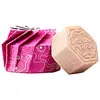What's inside
What's inside
 Key Ingredients
Key Ingredients

 Benefits
Benefits

 Concerns
Concerns

 Ingredients Side-by-side
Ingredients Side-by-side

Water
Skin ConditioningCocamidopropyl Betaine
CleansingSodium C14-16 Olefin Sulfonate
CleansingPolyquaternium-7
Sodium Cocoyl Isethionate
CleansingAcrylates Copolymer
Cocamide Mea
EmulsifyingGlycol Distearate
EmollientParfum
MaskingGlycerin
HumectantBenzyl Alcohol
PerfumingSodium Isostearoyl Lactate
CleansingPhenoxyethanol
PreservativeGlyceryl Laurate
EmollientSodium Benzoate
MaskingHydroxypropyl Methylcellulose
Emulsion StabilisingSodium Hyaluronate
HumectantPEG-150 Distearate
EmulsifyingTetrasodium EDTA
PPG-28-Buteth-35
Skin ConditioningPEG-14m
Emulsion StabilisingArgania Spinosa Kernel Oil
EmollientCamellia Sinensis Leaf Extract
AntimicrobialButylene Glycol
HumectantBiotin
AntiseborrhoeicNiacinamide
SmoothingCI 17200
Cosmetic ColorantCI 60730
Cosmetic ColorantWater, Cocamidopropyl Betaine, Sodium C14-16 Olefin Sulfonate, Polyquaternium-7, Sodium Cocoyl Isethionate, Acrylates Copolymer, Cocamide Mea, Glycol Distearate, Parfum, Glycerin, Benzyl Alcohol, Sodium Isostearoyl Lactate, Phenoxyethanol, Glyceryl Laurate, Sodium Benzoate, Hydroxypropyl Methylcellulose, Sodium Hyaluronate, PEG-150 Distearate, Tetrasodium EDTA, PPG-28-Buteth-35, PEG-14m, Argania Spinosa Kernel Oil, Camellia Sinensis Leaf Extract, Butylene Glycol, Biotin, Niacinamide, CI 17200, CI 60730
Sodium Cocoyl Isethionate
CleansingHydrogenated Coconut Acid
EmollientBehentrimonium Methosulfate
Cetearyl Alcohol
EmollientTheobroma Cacao Seed Butter
EmollientDioscorea Japonica Root Powder
Skin ConditioningAspergillus/Coffee Seed/Rice Ferment Filtrate
Skin ConditioningSodium Isethionate
CleansingWater
Skin ConditioningGlycerin
HumectantCetyl Alcohol
EmollientSodium Lactate
BufferingParfum
MaskingButyrospermum Parkii Butter
Skin ConditioningSimmondsia Chinensis Seed Wax
Skin ConditioningSaccharomyces Ferment
Skin ConditioningButylene Glycol
HumectantStearic Acid
CleansingOryza Sativa Powder
Polyquaternium-10
Bambusa Vulgaris Leaf Extract
Skin ConditioningBrassica Oleracea Italica Seed Oil
EmollientOryza Sativa Bran Oil
EmollientCalcium Pantothenate
Inositol
HumectantJojoba Esters
EmollientMaltodextrin
AbsorbentArginine
MaskingAspergillus Ferment
Skin ConditioningCaesalpinia Spinosa Fruit Extract
Skin ProtectingHelianthus Annuus Sprout Extract
Skin ConditioningHydrolyzed Vegetable Protein
Skin ConditioningTocopheryl Acetate
AntioxidantLavandula Angustifolia Oil
MaskingLeuconostoc/Radish Root Ferment Filtrate
AntimicrobialAloe Barbadensis Leaf Juice
Skin ConditioningAlteromonas Ferment Extract
Skin ConditioningLeuconostoc/Radish Root Ferment Lysate Filtrate
Skin ConditioningSodium Cocoyl Isethionate, Hydrogenated Coconut Acid, Behentrimonium Methosulfate, Cetearyl Alcohol, Theobroma Cacao Seed Butter, Dioscorea Japonica Root Powder, Aspergillus/Coffee Seed/Rice Ferment Filtrate, Sodium Isethionate, Water, Glycerin, Cetyl Alcohol, Sodium Lactate, Parfum, Butyrospermum Parkii Butter, Simmondsia Chinensis Seed Wax, Saccharomyces Ferment, Butylene Glycol, Stearic Acid, Oryza Sativa Powder, Polyquaternium-10, Bambusa Vulgaris Leaf Extract, Brassica Oleracea Italica Seed Oil, Oryza Sativa Bran Oil, Calcium Pantothenate, Inositol, Jojoba Esters, Maltodextrin, Arginine, Aspergillus Ferment, Caesalpinia Spinosa Fruit Extract, Helianthus Annuus Sprout Extract, Hydrolyzed Vegetable Protein, Tocopheryl Acetate, Lavandula Angustifolia Oil, Leuconostoc/Radish Root Ferment Filtrate, Aloe Barbadensis Leaf Juice, Alteromonas Ferment Extract, Leuconostoc/Radish Root Ferment Lysate Filtrate
Ingredients Explained
These ingredients are found in both products.
Ingredients higher up in an ingredient list are typically present in a larger amount.
Butylene Glycol (or BG) is used within cosmetic products for a few different reasons:
Overall, Butylene Glycol is a safe and well-rounded ingredient that works well with other ingredients.
Though this ingredient works well with most skin types, some people with sensitive skin may experience a reaction such as allergic rashes, closed comedones, or itchiness.
Learn more about Butylene GlycolGlycerin is already naturally found in your skin. It helps moisturize and protect your skin.
A study from 2016 found glycerin to be more effective as a humectant than AHAs and hyaluronic acid.
As a humectant, it helps the skin stay hydrated by pulling moisture to your skin. The low molecular weight of glycerin allows it to pull moisture into the deeper layers of your skin.
Hydrated skin improves your skin barrier; Your skin barrier helps protect against irritants and bacteria.
Glycerin has also been found to have antimicrobial and antiviral properties. Due to these properties, glycerin is often used in wound and burn treatments.
In cosmetics, glycerin is usually derived from plants such as soybean or palm. However, it can also be sourced from animals, such as tallow or animal fat.
This ingredient is organic, colorless, odorless, and non-toxic.
Glycerin is the name for this ingredient in American English. British English uses Glycerol/Glycerine.
Learn more about GlycerinParfum is a catch-all term for an ingredient or more that is used to give a scent to products.
Also called "fragrance", this ingredient can be a blend of hundreds of chemicals or plant oils. This means every product with "fragrance" or "parfum" in the ingredients list is a different mixture.
For instance, Habanolide is a proprietary trade name for a specific aroma chemical. When used as a fragrance ingredient in cosmetics, most aroma chemicals fall under the broad labeling category of “FRAGRANCE” or “PARFUM” according to EU and US regulations.
The term 'parfum' or 'fragrance' is not regulated in many countries. In many cases, it is up to the brand to define this term.
For instance, many brands choose to label themselves as "fragrance-free" because they are not using synthetic fragrances. However, their products may still contain ingredients such as essential oils that are considered a fragrance by INCI standards.
One example is Calendula flower extract. Calendula is an essential oil that still imparts a scent or 'fragrance'.
Depending on the blend, the ingredients in the mixture can cause allergies and sensitivities on the skin. Some ingredients that are known EU allergens include linalool and citronellol.
Parfum can also be used to mask or cover an unpleasant scent.
The bottom line is: not all fragrances/parfum/ingredients are created equally. If you are worried about fragrances, we recommend taking a closer look at an ingredient. And of course, we always recommend speaking with a professional.
Learn more about ParfumSodium cocoyl isethionate is a natural ingredient from coconut oil. It is an ultra gentle cleanser that gives a nice foam without drying the skin or impacting the skin barrier.
The amount of foam created depends on the amount of sodium cocoyl isethionate used in the product.
This ingredient also helps improve the spreadability of a product.
Learn more about Sodium Cocoyl IsethionateWater. It's the most common cosmetic ingredient of all. You'll usually see it at the top of ingredient lists, meaning that it makes up the largest part of the product.
So why is it so popular? Water most often acts as a solvent - this means that it helps dissolve other ingredients into the formulation.
You'll also recognize water as that liquid we all need to stay alive. If you see this, drink a glass of water. Stay hydrated!
Learn more about Water